The first time I heard jazz guitar, I was mesmerized. Those sultry tones and intricate rhythms seemed like an impossible dream for a beginner like me. But here’s the secret: jazz guitar isn’t as intimidating as it appears. In fact, with the right approach, anyone can start their journey into this rich musical world. As a guitarist with a master’s degree in Contemporary Improvisation, I’ve guided countless students through their introduction to jazz guitar, watching them transform from hesitant novices to confident players.
In this guide, I’ll share the techniques and insights I’ve gathered over years of performing and teaching. We’ll start with the basics, explore essential equipment, and gradually build up to your first licks. Whether you’re a complete beginner or looking to add jazz to your existing skills, I’m excited to help you unlock the magic of jazz guitar. Let’s embark on this musical adventure together!
Getting Started with Jazz Guitar
Essential Equipment

As we delve into essential jazz guitar knowledge, let’s talk equipment. Through my years editing Acoustic Guitar magazine, I’ve learned that the right gear can make or break your jazz journey. While a seasoned player can coax jazz tones from almost anything, beginners benefit from purpose-built instruments. I recommend starting with a hollow-body electric guitar – its warm, mellow tone is perfect for jazz. Pair it with a small, clean-sounding amp to capture those nuanced chord voicings. Don’t forget a handful of medium-gauge picks and a chromatic tuner. These essentials will set you on the right path, allowing you to focus on developing your technique rather than fighting your equipment. Remember, though, that even the best gear is just a tool – it’s your dedication and practice that will truly make you shine.
Understanding Jazz Guitar Basics
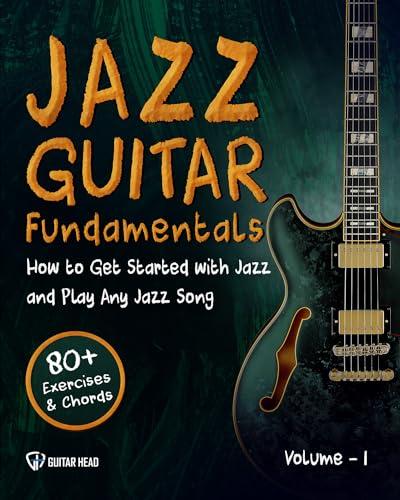
As I delve into jazz guitar basics, I’m reminded of the countless articles I’ve written for Premier Guitar and Acoustic Guitar. Understanding these fundamentals is like unlocking a musical treasure chest. Jazz guitar isn’t just about playing notes; it’s about feeling the rhythm, embracing the harmony, and finding your unique voice within the genre.
In my experience, mastering jazz guitar basics opens up a world of musical possibilities. You’ll start to hear familiar songs in a new light, recognizing the intricate chord voicings and smooth transitions that give jazz its distinctive flavor. As you progress, you’ll find yourself naturally incorporating these elements into your playing, whether you’re comping behind a soloist or taking center stage yourself.
I’ve seen many guitarists transform their playing by grasping these essentials. From understanding swing feel to navigating ii-V-I progressions, each concept builds upon the last, creating a solid foundation for your jazz journey. Remember, every jazz legend started with these same basics – they’re your stepping stones to musical greatness.
Fundamental Jazz Guitar Techniques
Simple Jazz Guitar Chords
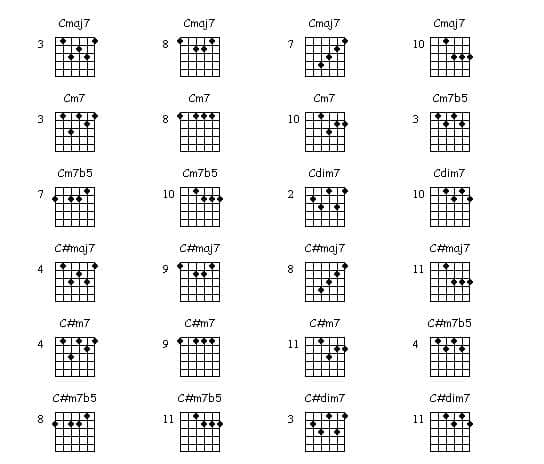
As we delve into simple jazz guitar chords, I’m reminded of the countless hours I’ve spent exploring this topic in my book ‘Color Your Chords’. These foundational elements are the building blocks of jazz harmony, and mastering them will open up a world of musical possibilities. In my experience, understanding these chords isn’t just about memorizing shapes; it’s about feeling the rich textures and colors they bring to your playing.
I’ve found that starting with basic seventh chords – major 7th, minor 7th, and dominant 7th – provides a solid foundation. These chords create the characteristic jazz sound we all love. As you practice, focus on voicings that use just three or four strings. This approach allows for easier transitions and cleaner execution, especially when comping or soloing. Remember, in jazz, less is often more. The beauty lies in how you use these simple chords to create complex harmonies and express your musical ideas.
By incorporating these simple jazz guitar chords into your practice routine, you’ll soon find yourself naturally adding jazzy flavors to your playing. This foundation will serve as a springboard for exploring more advanced techniques and expanding your harmonic vocabulary.
Introduction to Jazz Scales
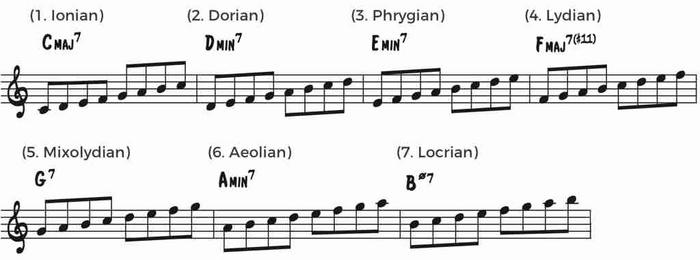
As we delve deeper into the heart of jazz guitar, we encounter one of its most crucial elements: jazz scales. In my years of exploring contemporary improvisation, I’ve come to appreciate how these scales form the backbone of jazz expression. They’re not just patterns of notes; they’re the building blocks of musical storytelling.
Jazz scales for guitar open up a world of melodic possibilities. When I first grasped their power, it felt like unlocking a secret language. From the soulful minor pentatonic to the sophisticated bebop scales, each offers a unique flavor and emotional palette. Mastering these scales isn’t just about memorizing patterns—it’s about internalizing the sounds and feelings they evoke.
As we explore these scales together, I’ll show you how they integrate seamlessly with the chords and arpeggios we’ve discussed. You’ll start to see the fretboard not as a daunting maze, but as a canvas for your musical ideas. This understanding will be crucial as we move forward, laying the groundwork for crafting your own licks and solos. Let’s embark on this journey of discovery, where theory meets creativity, and scales become the seeds of your unique jazz voice.
Basic Jazz Arpeggios
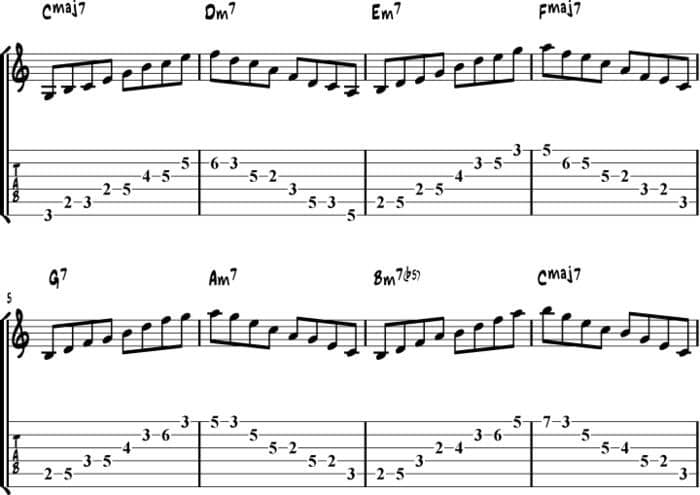
As I discovered while working on “Jim Hall: Signature Licks,” mastering basic jazz arpeggios is crucial for any aspiring jazz guitarist. These melodic patterns, derived from chord tones, are the building blocks of jazz improvisation. I’ve seen firsthand how Hall and other greats use arpeggios to create fluid, expressive solos. For beginners, starting with simple major and minor arpeggios can open up a world of melodic possibilities. By practicing these patterns across the fretboard, you’ll develop muscle memory and a deeper understanding of chord structures. Jazz arpeggios for beginners not only enhance your soloing capabilities but also improve your chord recognition and fretboard navigation. As you progress, you’ll find that these fundamental shapes become second nature, allowing you to focus on crafting more complex and engaging musical ideas.
Your First Jazz Guitar Licks
Simple Jazz Lick Exercises
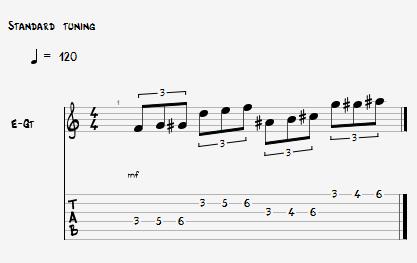
As we dive into simple jazz lick exercises, I’m reminded of my countless hours transcribing solos. These exercises are crucial stepping stones to mastering jazz improvisation. I’ve designed a series of jazz guitar exercises that will help you internalize essential patterns and develop muscle memory. Start by practicing short, two-bar licks in different keys, focusing on smooth transitions between notes. Repetition is key, but always strive for musicality. Gradually increase complexity by incorporating chromatic approach notes and rhythmic variations. Remember, these licks are your musical vocabulary – the more you practice, the more fluent you’ll become in the language of jazz. As you work through these exercises, you’ll notice your fingers naturally gravitating towards jazz-friendly positions, setting a solid foundation for the next step: applying these licks to actual songs.
Applying Licks to Easy Jazz Songs

Now that you’ve learned some basic licks, it’s time to put them into action. As an engraver, I’ve seen countless jazz standards, and I can assure you that applying licks to easy jazz songs is a crucial step in your journey. Let’s start with some accessible tunes that will help you build confidence and musicality.
I recommend beginning with classic easy jazz guitar songs like “Autumn Leaves” or “Blue Bossa.” These songs have simple chord progressions that are perfect for practicing your new licks. Start by identifying the key and chord changes, then experiment with placing your licks over different parts of the song. Don’t be afraid to modify the licks slightly to fit the melody or harmony better.
Remember, the goal isn’t to play the lick exactly as you learned it, but to use it as a springboard for your own ideas. As you become more comfortable, try combining different licks or creating variations. This process of application and experimentation is where the real magic of jazz improvisation begins to unfold.
Developing Your Jazz Guitar Practice Routine
Daily Exercises

In my years of creating jazz guitar tutorials, I’ve learned that daily exercises are the cornerstone of any effective practice routine. I recommend starting each session with finger warm-ups and dexterity drills. Spend 10-15 minutes on scales, focusing on different patterns and positions each day. Next, dedicate time to chord progressions, practicing transitions and voicings. Arpeggios are crucial for soloing, so incorporate them daily. Finally, work on a specific lick or phrase, gradually increasing tempo and complexity. Remember, consistency is key. Even 30 minutes of focused practice each day will yield significant improvements. As you progress, adjust your routine to challenge yourself and maintain engagement. These exercises will build your technical foundation and musical vocabulary, essential elements for jazz improvisation and performance.
Progressing with Jazz Chord Progressions

As we delve into jazz chord progressions, I’m reminded of my journey crafting guitar instruction books. Through countless hours of research and practice, I’ve honed a method to help you master these essential building blocks. Remember, progressions are the backbone of jazz—they provide the harmonic framework for melodies and improvisations.
Let’s start with the iconic ii-V-I progression. I’ll guide you through playing it in various keys, gradually increasing complexity. We’ll explore voice leading techniques to smooth out your transitions. As you progress, we’ll tackle more advanced progressions like the “rhythm changes” and modal jazz sequences. I’ve found that consistent, focused practice is key to internalizing these patterns.
By integrating chord progressions into your daily routine, you’ll develop a deeper understanding of jazz harmony. This knowledge will significantly enhance your comping and soloing abilities, paving the way for more creative improvisation. Trust me, the effort you put into mastering progressions now will pay dividends in your overall jazz guitar journey.
Tips for Successful Jazz Guitar Learning
Effective Practice Techniques
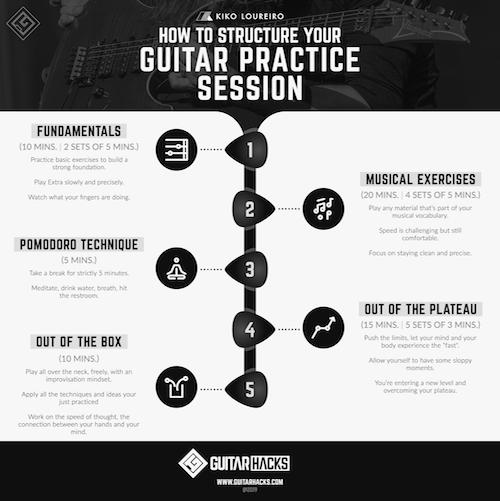
As a seasoned jazz guitar instructor, I’ve found that effective practice techniques are crucial for beginners learning jazz guitar. One key strategy I always emphasize is focused, deliberate practice. Rather than mindlessly noodling, set specific goals for each session. Start with short, manageable chunks of time—even 15 minutes can be productive if you’re fully engaged.
I recommend using a metronome to develop rock-solid timing, an essential skill in jazz. Slow practice is another powerful technique. By practicing at a reduced tempo, you can iron out technical kinks and really internalize the feel of jazz rhythms. Don’t forget to record yourself regularly; it’s an eye-opening way to track your progress and identify areas for improvement. Remember, consistency trumps intensity. Daily practice, even if brief, will yield better results than sporadic marathon sessions.
Introduction to Jazz Improvisation

As we delve into jazz improvisation on guitar, I’m excited to share insights from my master’s degree in Contemporary Improvisation. This journey into creative soloing is where jazz truly comes alive. Improvisation is the heart and soul of jazz, allowing you to express your unique voice through your instrument.
To begin, focus on internalizing the chord progressions of jazz standards. This foundation will guide your improvisations. Next, explore the relationship between chords and scales. Understanding how to apply the right scale over each chord is crucial. Start with the blues scale – it’s versatile and forgiving for beginners.
As you progress, experiment with rhythmic variations and phrasing. Listen closely to jazz masters and try to emulate their style. Remember, great improvisation isn’t just about playing the right notes; it’s about telling a story through your music. Practice transcribing solos to develop your ear and expand your musical vocabulary.
Don’t be afraid to make mistakes. Jazz improvisation is about taking risks and learning from them. With consistent practice and an open mind, you’ll soon find yourself crafting compelling solos that reflect your unique musical voice.
FAQs
What are the essential components of a jazz guitar setup?
A basic jazz guitar setup includes:
- A hollow-body or semi-hollow electric guitar
- A clean-sounding amplifier
- Medium gauge strings (typically .011 to .052)
- A metronome for practicing rhythm
- Optional: A looper pedal for solo practice
What are the fundamental chords every beginner jazz guitarist should learn?
Beginners should focus on learning these essential jazz chords:
- Major 7th (Maj7)
- Minor 7th (m7)
- Dominant 7th (7)
- Half-diminished 7th (m7b5)
- Augmented (aug)
Start with these in various positions and keys to build a solid foundation.
How can I develop my jazz improvisation skills?
To improve your jazz improvisation:
- Learn and practice major and minor scales in all positions
- Study and internalize common jazz progressions (e.g., ii-V-I)
- Transcribe solos from jazz masters
- Practice with backing tracks or a looper pedal
- Experiment with rhythm and phrasing
- Join jam sessions to play with others
What’s a good first jazz lick for beginners to learn?
A simple yet effective jazz lick for beginners is the “Honeysuckle Rose” lick:
- Start on the root note of the chord
- Play the 9th (one whole step above the root)
- Then the 3rd of the chord
- Finish with the 5th
Practice this lick in different keys and over various chord progressions to internalize its sound and feel.
How often should I practice to improve my jazz guitar skills?
To improve your jazz guitar skills:
- Aim for daily practice, even if it’s just 15-30 minutes
- Consistency is more important than long, infrequent sessions
- Focus on specific areas (e.g., chords, scales, licks) in each practice session
- Use a practice journal to track progress and set goals
- Listen to jazz regularly to develop your ear and style
Remember, quality practice is more important than quantity. Stay focused and engaged during your practice time for the best results.
Conclusion
Are you ready to take your first confident steps into the captivating world of jazz guitar? With the foundational knowledge and techniques we’ve explored, you’re now equipped to begin your exciting journey. Remember, learning how to play jazz guitar is a continuous process of growth and discovery.
As someone who has dedicated years to mastering and teaching jazz guitar, I can assure you that the rewards far outweigh the challenges. Start with the basics we’ve covered – essential chords, scales, and simple licks – and gradually build your skills. Practice regularly, experiment with improvisation, and don’t be afraid to make mistakes. They’re an integral part of the learning process.
I encourage you to immerse yourself in jazz, listen to the greats, and most importantly, enjoy every moment of your musical journey. The world of jazz guitar is vast and inspiring – embrace it with open arms and an eager mind. Your adventure in jazz starts now!